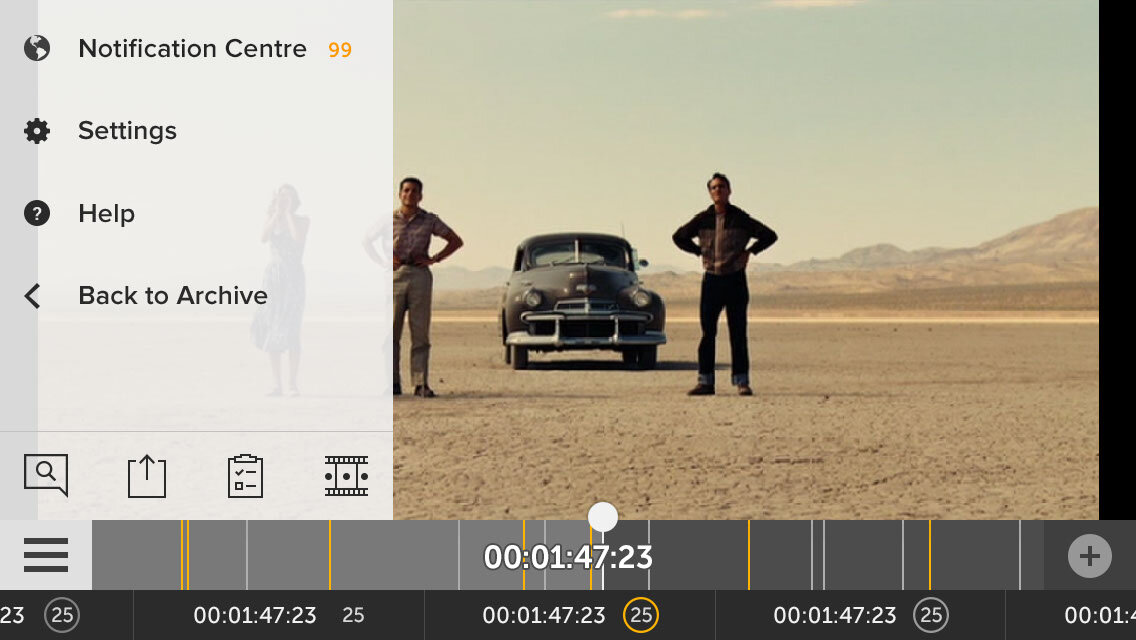
Critique Cloud
The challenge
How to scale the experience for a post production video platform
Digital Film Tree came to me needing a new way forward for the video workflow app Critique Cloud. This powerful sharing and commenting platform had already addressed the key issues of product market fit and had begun an impressive adoption curve in tv production studios. And best of a handful of influential show-runners were already fans of the simple UI and the convenient cloud based workflows. But they had a looming problem.
The app’s early success was defined by ease of use and intuitive workflows, how can the product experience evolve to a studio level workhorse.
Services
• UX research • User ethnography • Design analysis •Flow design • Wireframing

Digging for useful truths
Fact finding always starts with user interviews. I was able to speak with the technical minds that created the product, user success and sales team members, video editors, show executives, and a wide range of film/tv professionals. In tandem I performed a deep UX audit to assess the current product across all platforms.
Knowing the people
High-stake complicated workflows are not only hard to map as a set of function requirements but also hard to untangle for their political requirements. In studio level production some groups of users are inside the work day-in and day-out and sometimes irrationally committed to achieving a vision for a production. Other need line of sight but expect to have little stirring responsibilities. And yet others contributors act as critical gatekeepers for completion.
All these groups need to be understood for their goals, pains, and place in the pecking order. Scaling inside a studio requires that hierarchies, work domains, and approvals all be facilities while not sacrificing speed of creation and collaboration.
Key user personas
Show creatives
Writers, Directors, Assistant directors
Needs: Easy way to review cuts, give detailed feedback, traffic requests for changes reverse production teams
Pains:
Giving feedback to the edit without spending all day in an edit suite
Giving different layers of feedback to story, technique, technical execution
Consolidating feedback to reduce redundant and contradictory input
Show producers
Show runners, Producers
Needs: Easy way to track edit progress cuts, give detailed feedback, flag items for review by studio team
Pains:
Tracking multiple edit links across emails
Controlling who has access to what material before approval
Moving the process forward to keep schedule
Post production team
Post producer, Editors, Colorists, Sound editors
Needs: Easy to distribute channel for small clip sequences and full edits to internal team and to executives for notes
Pains:
Extra work to export and distribute cuts
Version control
Permissions for select reviewer groups
Executives
Executive producers, Studio executives, Legal, Standards and practices
Needs: effortless line of sight into production output
For notes and studio/legal review
Pains:
Complicated video protection protocols
Inclusion late in the game
Being tied to internal systems for video review
Research findings
Useful but siloed feature set
Users recognized the app as a tool strictly for whatever their primary use case, limiting exploration and developing deeper use.
Instructional prompts were inconsistent across mobile and web-base
Micro copy was confusing and very limited

UX gap analysis
Two experiences masked as one
Auditing the mobile and browser-based experiences was critical. The two versions of the product establish very different patterns and expectations. Any user who’s workflow required them to span both versions of the product would have two separate learning curves. This congestive load was preventing users from adopting advanced features across platforms.
UX audit findings
Fractured design teams created fractured products
Tool icon used the same metaphors but the styling and placement were different creating confusion and frustration
File navigation was based on different models, this prevented users from feeling grounded in “place.” This resulted in users relying on links instead of in-app file navigation
Small friction kills what should be an effortless hand off from mobile to web-based experience
Mobile users rarely used the web-based version, and vise versa
Audit take aways
Designing a unified experience
Grounding the users expectations by ensuring similar patterns, symbols and flows regardless of platform
Embed more useful information and actions into the clip list view
Make the player an intuitive center for collaboration
Product experience solutions
Color updates
Icon & tool bar updates
File navigator updates
Player & comment updates

A clever sharing tool or a production backbone?
Admin from the user out
From the interviews with executive producers and show runners it became clear that the product was missing a set of functionalities that was preventing studio-level adoption. As a sharing and commenting tool Critique was already a great match. But executives were worried about rolling it out as the single point of truth because access and permission settings were very rudimentary. Keeping unrealized media from leaking ahead of the distribution schedule is very important to secure the value of the production. Studio and legal teams needed to feel secure is a way to shut down all access and track back changes and downloads all from a central point.
The permission model was established at the clip level and then evolved to a folder based system. But it did not track user changes over time. This left a hole administrators ability know who had what access across the project file structure and to see when changes were being made and by whom.
Admin take aways
No robust admin platform to track commenting and access
Administrative tools were not part of the original design, while clip specific permissions were baked in, permission at scale was very daunting for the internal development team
Finer-grain permissioning and user types were needed
User activity was tracked but no actions were built into the product based on this data
Admin experience solutions
Clip level permission controls
User analytics view
User level permission dashboard
Project level overview
Outcomes
Implemented recommendations to further the company goal of creating a global post production workflow
Expanded network and studio production clients
Digital Film Tree went on to offer a full service production management business on top of the Critique platform












